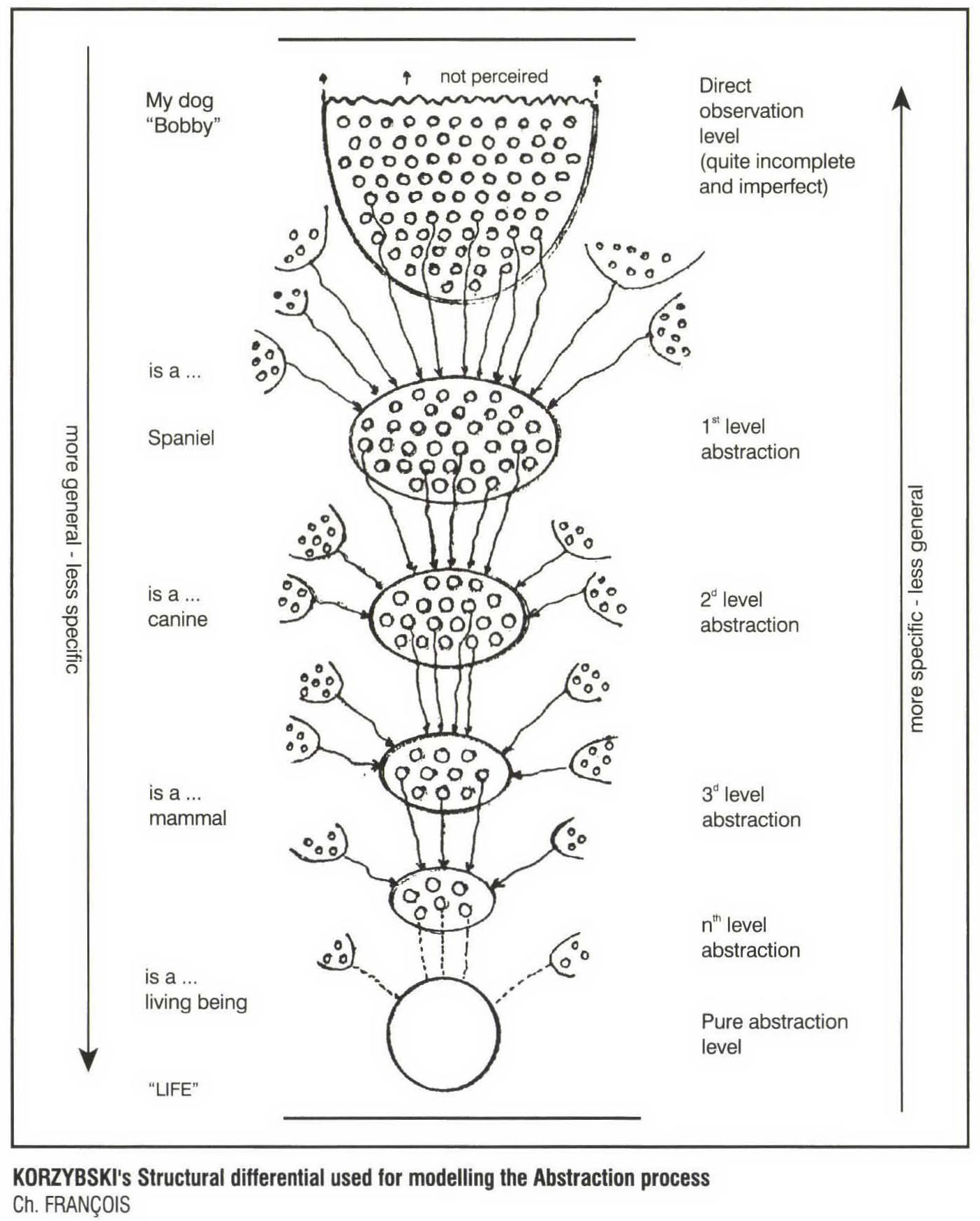STRUCTURAL DIFFERENTIAL 2)
← Back
A diagram that can be used to clarify the semantic aspects of an observer's relations with "reality".
The Structural Differential was introduced in 1933 by the Polish-American linguist and psychologist A. KORZYBSKI (1950a, p.387). His point was to induce a clear perception of the differences between outside reality, perception, description and labelling. He writes (observe his use of quote marks, which mean in every case "that something that we call…"):
"If we take something, let us say the object… called "pencil", and enquire what it represents, according to science 1933, we find that the "scientific object" represents an "event", a mad dance of "electrons", which is different every instant, which never repeats itself, which is known to consist of extremely complex dynamic processes of very fine structure, acted upon by, and reacting upon, the rest of the universe, inextricably connected with everything else and dependent on everything else. If we inquire how many characteristics… we should ascribe to such an event, the only possible answer is that we should ascribe to an event infinite numbers of characteristics, as it represents a process which never stops in one form or another; neither, to the best of our knowledge, does it repeat itself.
"In our diagram… we indicate this by a parabola A, which is supposed to extend indefinitely, which extension we indicate by a broken off line B. We symbolize the characteristics by small circles C, the number of which is obviously indefinitely great.
"Underneath, we symbolize the "object" by the circle O, which has a finite size. The characteristics of the object we also denote by similar little circles C'. The number of characteristics which an object has is large, but finite, and is denoted by the finite number of the small circles C'.
"Then we attach a label to the object, its name, let us say "pencil", which we indicate in our diagram by the label L. We ascribe also characteristics to the label and we indicate these characteristics by the little circles C".
"The number of characteristics which we ascribe by definition to the label is still smaller than the number of characteristics the object has. To the label "penciI1" we would ascribe, perhaps its length, tickness, shape, colour, hardness. But we would mostly disregard the accidental characteristics, such as a scratch on its surface, or the kind of glue by which the two wooden parts of the objective "pencil" are held together. If we want an objective "pencil" and come to a shop to purchase one, we say so and specify verbally only these characteristics which are of particular immediate interest to us…
"If we inquire as to the neurological processes involved in registering the object, we find that the nervous system has abstracted, from the infinite numbers of sub-microscopic characteristics of the event, a large but finite number of macroscopic characteristics…
"But this is not all. The object represents in this language a gross macroscopic abstraction, for our nervous system is not adapted for abstracting directly the infinite number of characteristics which the endlessly complex dynamic structure of the event represents. We must consider the object as a first abstraction (with a finite number of characteristics).
…
"The label, the importance of which lies in its meanings to us, represents a still higher abstraction from the event, and usually labels, also, a semantic reaction" (1950, p.387-9).
It is impossible to do justice to KORZYBSKI fundamental work through a short quotation.
He also uses the structural differential to clarify the relations between different labels of the same "object" and the successively more abstract labels that can be attached for different purposes, to an event as for example: "Max", "German shepherd", "dog", "mammal", "vertebrate", "animal", "living being", "life".
The content of his work constitutes a complete course in mental sanitation and he must be considered one of the most important pioneers of Systemics.

Categories
- 1) General information
- 2) Methodology or model
- 3) Epistemology, ontology and semantics
- 4) Human sciences
- 5) Discipline oriented
Publisher
Bertalanffy Center for the Study of Systems Science(2020).
To cite this page, please use the following information:
Bertalanffy Center for the Study of Systems Science (2020). Title of the entry. In Charles François (Ed.), International Encyclopedia of Systems and Cybernetics (2). Retrieved from www.systemspedia.org/[full/url]
We thank the following partners for making the open access of this volume possible:

